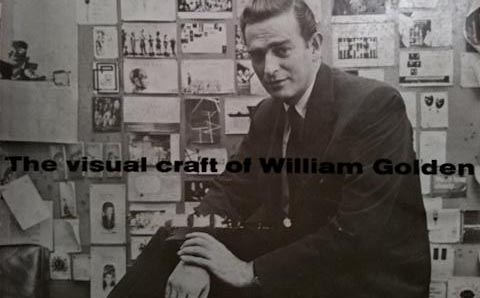

The Creative Integrity of William Golden

Recently I revisited The Visual Craft of William Golden, a book published in the early-Sixties about the legendary CBS creative director. There is an essay in the book by CBS exec John Cowden that sheds light on Golden’s artistic integrity, and helps to explain why the advertising work created under his guidance remains to this day the strongest body of advertising ever created for a TV network.
Golden’s world revolved around graphic design, illustration and advertising, but I find his experiences to be relevant to creative people working in any commercial field, and especially animation. For example, Cowden recounted how Golden was offered a promotion from creative director to an upper management position. Golden flatly turned down the offer, Cowden wrote:
Many years ago, when he was offered the title of Vice President in charge of Advertising and Sales Promotion, he said no thanks. His reasons were significant–and characteristic. He said the stripes would be bars…that they would force him to become a “company man”…to take the so-called “broad view” at the expense of principle.
Bill preferred to keep his independence and to preserve his inalienable right to shout–when the occasion demanded–that the emperor wasn’t wearing any clothes. In any case, he said he didn’t want to go to meetings, or be snowed under by administrative duties. I mention this because it reveals how Bill was willing to sacrifice anything–including his own advancement–if he felt it stood in the way of better design and advertising.
The story, incidentally, has an ironic but delightful ending. In scorning the conventional status symbols, Bill won far more. By turning down a vice presidency, he eventually gained a respect and status that outranked any vice president in the company.
Contrast Golden’s unwavering integrity to all of the animation artists in recent years who have moved into high-profile executive and management positions. In every case–with the notable exception of John Lasseter–these artists have unwittingly weakened their creative influence and become part of the problem by entrenching themselves within broken production systems.
Golden, who refused to become a part of upper management, also had his own ways of dealing with clueless business people. Again, from Cowden’s essay:
This integrity and pride in craft were also apparent in his willingness to lay his job on the line if anyone tried to invade his special area of responsibility. I remember a layout for a rate card he once submitted to his superior–the President of the Division. It came back by messenger with a note saying “I don’t like it very much. Let’s discuss.” Bill’s answer was simply to scotchtape a drawing pencil to the corner of a large layout pad and send it back with this message scribbled across the top sheet: “Let’s not. Why don’t you make a better one.” There was no reply. The rate card was produced as originally designed.
Here’s another example of how he dealt with the endless stream of unqualified individuals who tried to encroach on his domain:
Bill flatly refused to submit art for approval to anyone. On another occasion, he commissioned the artist Rene Bouché to do a drawing of a certain television star for a newspaper ad. When the star saw the sketch in the paper he exploded. He demanded that only authorized photographs be used in all future ads. I was one of many who urged Bill not to make an issue of the matter but to go along with the request. Instead, Bill immediately commissioned Bouché to do another drawing of the same performer and again refused to show it to the star. Eventually the new sketch appeared in another ad and became the famous trademark–on the air and off–of America’s all-time favorite comedian: Jack Benny.
Bill Golden demanded the best, and didn’t accept excuses from artists:
Nothing upset [Golden] more than someone who alibied his samples on the ground that his particular client would not let him do good work. Bill maintained–and proved it at CBS–that there are no good or bad clients, there are only good or bad advertising men.
Unlike so many blockheads in positions of power within the contemporary animation industry, Golden could identify skill and talent with his trained eye. This is evidenced by the group of people who worked for him, which is a who’s who of mid-century illustration and design giants: David Stone Martin, Feliks Topolski, Leo Lionni, Joe Kaufman, George Lois, Ludwig Bemelmans, Ben Shahn, Miguel Covarrubias, and Jan Balet, to name but a few. Cowden’s memories of Golden are a reminder that great commercial work, whether it’s a piece of print design or an animated film, doesn’t happen by accident. It happens because of this:
[Golden] accepted the fact that part of the responsibility of being an advertising man and a designer was to have the courage of one’s convictions…a bulldog tenacity…a willingness to do daily battle for the things one believed in…and the recognition that constant vigilance is the price of freedom.

.png)